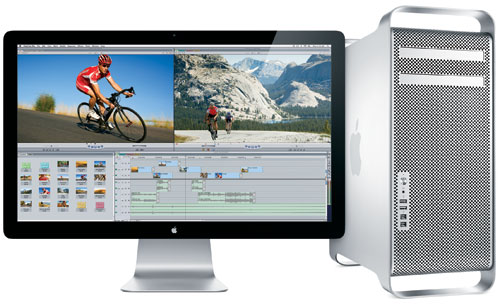Hosted by site sponsor WebMate.
Silver Tower Mac Pro (Dual Optical) Q&A - Published June 3, 2013
All Mac Q&As >> Silver Tower Mac Pro Dual Optical Q&A (Home)
To be notified of new Q&As, sign up for EveryMac.com's bimonthly email list.
How fast are the "Mid-2012" Mac Pro models compared to one another? How fast are the "Mid-2012" Mac Pro models compared to the "Mid-2010" models replaced? Are they actually faster?
The "Mid-2012" Mac Pro models are such a minor revision that Apple did not even issue a press release heralding their introduction.
However, in other promotional copy, Apple did reveal that the fastest custom configuration "Mid-2012" Mac Pro -- the Mac Pro "Twelve Core" 3.06 (2012/Westmere) -- is between 1.2 and 1.5 times faster than the fastest custom configuration "Early 2009" Mac Pro -- the Mac Pro "Eight Core" 2.93 (2009/Nehalem).
First, it is worth noting that this official comparison is a synthetic performance test using the "STREAM" 5.8 benchmark, and is a comparison with the much earlier "Early 2009" line rather than the previous, and effectively identical, "Mid-2010" Mac Pro line.
Obviously, a comparison between the "Mid-2012" and the "Mid-2010" Mac Pro lines will be much less impressive, but is necessary for objectivity.

Photo Credit: Apple, Inc. (Mac Pro)
General Performance Overview
For a solid overview of the performance difference between the "Mid-2012" Mac Pro models as well as earlier Mac Pro systems, EveryMac.com's own Ultimate Mac Comparison makes it quick to compare side-by-side 32-bit-and 64-bit Geekbench benchmark averages with all other G3 and later Macs for thousands of possible performance comparisons.
The Geekbench benchmark shows that the custom configured six-core model -- the Mac Pro "Six Core" 3.33 (2012/Westmere) -- is roughly 43% faster than the entry-level quad core model -- the Mac Pro "Quad Core" 3.2 (2012/Nehalem). The standard twelve-core model -- the Mac Pro "Twelve Core" 2.4 (2012/Westmere) -- is a massive 79% faster than the entry-level model and a significant 25% faster than the six-core model.
Geekbench also shows that the custom configured twelve-core models -- the Mac Pro "Twelve Core" 2.66 (2012/Westmere) and "Twelve Core" 3.06 (2012/Westmere) -- are 15% and 25% faster than the standard twelve-core model. The fastest twelve-core model is a whopping 125% faster than the entry-level quad core model.
Compared to the "Mid-2010" line, Geekbench shows that the "Mid-2012" systems are between 0% and 38% faster than the model each roughly replaced (Apple consolidated six models to five):
| Mid-2010 Mac Pro | Mid-2012 Mac Pro | Percent Faster |
| "Quad Core" 2.8 / 3.2 | "Quad Core" 3.2 | 14% / Identical |
| "Six Core" 3.33 | "Six Core" 3.33 | Identical |
| "Eight Core" 2.4 | "Twelve Core" 2.4 | 38% |
| "Twelve Core" 2.66 | "Twelve Core" 2.66 | Identical |
| "Twelve Core" 2.93 | "Twelve Core" 3.06 | 2% |
Other Benchmarks & Real-World Test Results
Geekbench provides a convenient overview of overall performance, but other benchmarks and real-world tests still can be useful.
Because the "Mid-2012" Mac Pro models were such a modest update, most of the blogosphere declined to perform any detailed testing, but the industry-standard Macworld was the exception. In its testing, the publication found:
The new quad-core 3.2 GHz Mac Pro is 16 percent faster overall than the 2010 quad-core 2.8 GHz Xeon Mac Pro, which is certainly nothing to sneeze at. The new system is 8 percent faster than the 2010 eight-core 2.4 GHz Xeon Mac Pro. Going back further, the new system is 44 percent faster than the 2009 low-end quad-core 2.66 GHz Xeon Mac Pro. While the file duplication test results are pretty much identical between the new low-end and the 2010 low-end Mac Pro, some tests were considerably faster on the new system, helped by a 14 percent faster processor and twice the RAM. Photoshop, for example, is 31 percent faster than the 2010 quad core model.
The new 12-core 2.4 GHz Mac Pro is 10 percent faster overall than the 2010 eight-core 2.4 GHz Xeon Mac Pro, and 31 percent faster from the 2009 eight-core 2.26 GHz Xeon Mac Pro.
Although Macworld primarily used application tests -- which can be more precise for "real world" evaluation than the theoretical Geekbench benchmark -- the variation between "pretty much identical" and as much as 31% faster still is apparent.
Performance Summary
Ultimately, although the "Mid-2012" Mac Pro models provide a bit more value and a bit more performance than the "Mid-2010" models replaced, they clearly have aged architecturally and provide little reason for someone with a "Mid-2010" or even "Early 2009" Mac Pro to buy a new model compared to simply upgrading their existing systems.
To purchase a used Mac Pro, high-quality storage or memory for the Mac Pro, visit site sponsor Other World Computing.
Permalink | Report an Error/Typo | Sign Up for Site Update Notices
<< Mac Pro Dual Optical Drives Q&A (Main) | All Mac Q&As
Established in 1996, EveryMac.com has been created by experts with decades of experience with Apple hardware. EveryMac.com includes, and always has included, original research incorporating detailed, hands-on inspection of packaging, computers, and devices as well as extensive real-world use. All information is provided in good faith, but no website or person is perfect. Accordingly, EveryMac.com is provided "as is" without warranty of any kind whatsoever. EveryMac.com, and the authors thereof, shall not be held responsible or liable, under any circumstances, for any damages resulting from the use or inability to use the information within. For complete disclaimer and copyright information please read and understand the Terms of Use and the Privacy Policy before using EveryMac.com. Copying, scraping, or use of any content without expressed permission is not allowed, although links to any page are welcomed and appreciated.
